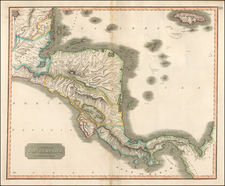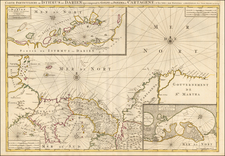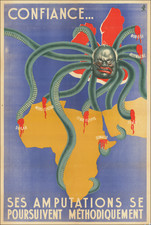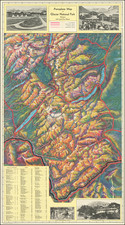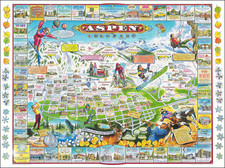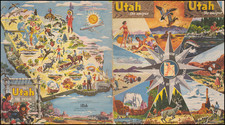One of the Great Triumphs of Early American Flight and Filmmaking. The Only Known Example.
A colossal (9¼ x 13½ feet) bird's-eye view poster promoting the pioneering 1914 silent film Panama and the Canal from an Aeroplane.
The movie documented the first and, at the time it was released, only non-stop flight between the Pacific and the Atlantic Oceans. This feat by the famed airman Robert Fowler gripped the nation, both because of its daring nature and because it led to his unsuccessful prosecution by the US government for unauthorized photography of military installations. Completed in 55 minutes in the single-engine hydroplane seen on the poster, this was the first-ever transcontinental flight.
The film greatly influenced American policymaking with respect to aerial photography and overflights of strategically important installations. It was made just before the outbreak of the First World War, when Britain, France, and Germany had all already started experimenting with military aerial photography. This tension is evident on the poster, which says the film made during the flight "are probably the only pictures that will ever be taken of the canal from the air, except for purposes of war."
Critical reception of the film was glowing. The Los Angeles Evening Express said of the film that "The pictures have been regarded as among the most remarkable ever produced." However, the government was less warm regarding the production. A warrant for Fowler's arrest was issued in July of 1914. He was arraigned in San Francisco alongside his cameraman (Ray Duhem) and the writers and editors of Sunset Magazine who published the not-so-subtle Can the Panama Canal Be Destroyed from the Air? An executive order by Woodrow Wilson was signed immediately after explicitly forbidding flights like Fowler's. The case was eventually dropped but the executive order stood.
Fowler's Flight
Fowler had previously captured national attention with his February 1912 trip from San Francisco to Jacksonville, making the first such West-to-East flight across the United States. He had first attempted to complete the flight in September 1911 but crashed after one day in Alta, California.
Fowler's next goal was to become the first person to make a transcontinental flight. The Isthmus of Panama provided the obvious location, however, adverse winds in the Culebra cut made such a journey perilous. He nevertheless completed the flight in fifty-five minutes (sources vary, some state fifty-seven minutes and others one-and-a-half hours), flying from Panama City to Colón.
The New York Times account of the flight states:
Robert G. Fowler, the aviator, successfully flew from the Pacific over the canal this morning in a hydroaeroplane with a passenger, landing at the Atlantic side, in fifty-five minutes. A picture was taken of the operator and machine in motion. The flight has frequently been termed impossible on account of the air currents over Culebra. Fowler flew directly over the cut, and was able to carry out various evolutions despite wind obstacles. Leaving Panama Beach at 9:45 A. M., he circled over the canal's entrance for a while then rose high and steered toward Colon, where he encountered a twenty-five-mile breeze. In continuing to Cristobal the motor suddenly stopped, after missing fire, through the gasoline giving out. Fowler succeeded in landing with ease on a reef. The pontoon was torn, but otherwise his machine was undamaged.
The Gage biplane that was used for the flight is now preserved at the Smithsonian's Udvar-Hazy facility.
Fowler's Return and Prosecution
Fowler's flight seemed designed, from the onset, to stir unease in the military. Fowler certainly seemed to have had an interest, whether patriotic or commercial, in convincing the U.S. military to invest in airplanes for the defense of the Panama Canal and potentially other military installations. A short wire service sent shortly after the flight provides insight into these issues:
AEROPLANES WANTED TO PROTECT THE PANAMA CANAL
NEW ORLEANS, May 13.-- Aeroplanes and hydroaeroplanes are to be used in fortifying the Panama canal.
Robert G. Fowler, California aviator, returned here from Panama and reported that Col. George Goethals would ask congress to make appropriations to buy air machines as part of the canal fortifications.
After the aforementioned Sunset article was published, Fowler, his cameraman, a Sunset editor, and a writer were arrested under a 1911 law that, according to the prosecutor on the case, "strengthened the regulation so that it is now a violation of a plain statute for a civilian to take or publish photographs of any fortification, whether complete or in progress." Sunset responded to the allegations as follows:
This is one of the most significant photographs ever published in this country. Below the aeroplane from which the picture was taken lie the Naos Islands, in the Bay of Panama, on which the United States Government is now mounting batteries of the heaviest artillery in the world, to protect the Pacific approach to the Panama Canal.
The case was eventually dropped as it appeared that the law's authors had not anticipated aerial photography, and the executive order signed by Wilson strengthened this statute. Further, Fowler's flight had even been encouraged by the canal's chief engineer, Colonel George Washington Goethals.
The promoters of the film clearly saw an opportunity to benefit from this attention. The poster makes reference to these events:
these remarkable pictures were taken by Ray A. Durem from the hydro-aeroplane of the noted aviator Robert G. Fowler under unusual difficulties. Fowler made a daring flight across the isthmus from the Pacific to the Atlantic, so far the only aviator to make the journey. Shortly afterward, President Wilson issued an Executive Order forbidding such flights under heavy penalty. The photographs made on this flight, in themselves a notable achievement in motion photography, are probably the only pictures that will ever be taken of the canal from the air except for purposes of war.
Rarity
We trace no other examples of the poster, it is possibly a unique survival. OCLC/WorldCat locates only one poster from this film, a significantly smaller one-sheet version, held at UC Berkeley, but no copies of this rare version.
The Schmidt Lithography Company was based in San Francisco. Max Schmidt, a German immigrant, founded his first printing business in 1873, and he was one of the first printers to use lithography on the West Coast. His plant burned twice, in 1884 and 1886, but by the 1890s he ran a factory in San Francisco, as well as branches in Portland and Seattle.
During the 1906 earthquake and fire the company’s premises were destroyed again. Schmidt quickly acquired a nearby paper factory and production continued practically uninterrupted. Within two years of the fire, Schmidt had rebuilt on the site of his former factory at the corner of Second and Bryant Streets.
Schmidt’s company was best known for its printed labels, but they also produced other items like separately-issued prints. The company was once the largest printing company on the West Coast and today they are remembered for the clock tower that still stands at Second and Bryant Streets.











